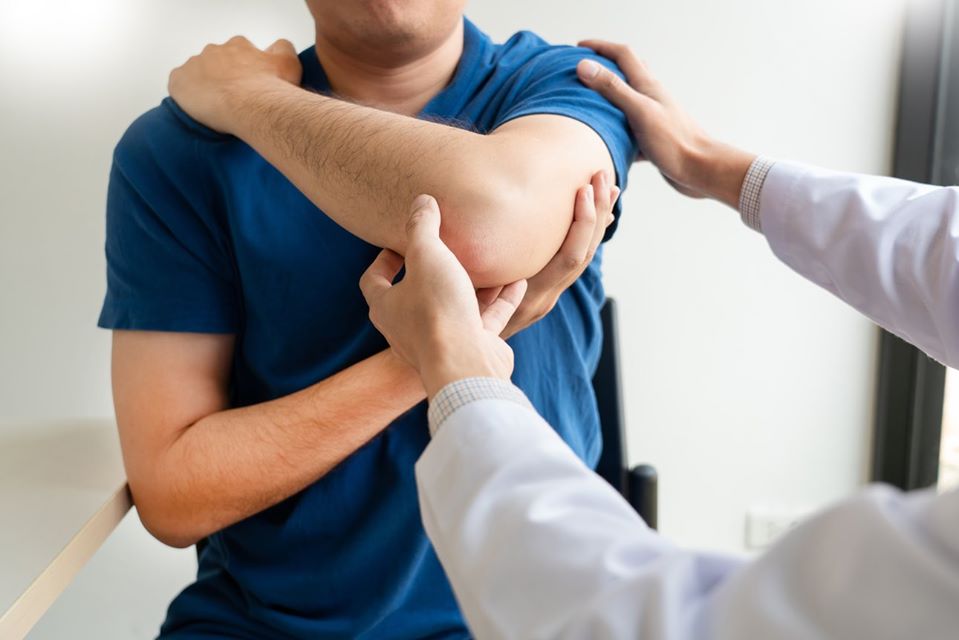Diagnosis and Treatment of Elbow Bursitis in Wake County

What is Elbow Bursitis?
If you’ve noticed that your elbows are red or swollen, it could be a sign that you have elbow (olecranon) bursitis. Bursitis refers to inflammation of a part of the body called a bursa, which is a small, jelly-like sac that contains a small amount of lubricating fluid. This allows the soft tissues to move freely over the underlying bone. Bursitis is common in the shoulder, elbow, hip, knee, and heel.
Elbow bursitis occurs in the olecranon bursa which is located at the bony tip of the elbow, known as the olecranon. Normally, the olecranon bursa is flat. If it becomes irritated or inflamed, more fluid will accumulate in the bursa and bursitis will develop.

Causes of Elbow Bursitis
Elbow bursitis can occur for a number of reasons. Often, the condition arises due to the amount of stress put on the joint itself. Leaning on the tip of the elbow for long periods of time on hard surfaces, such as a tabletop, may cause the bursa to swell. People in certain occupations are especially vulnerable, particularly plumbers or heating and air conditioning technicians who have to crawl on their knees in tight spaces and lean on their elbows. Certain athletic activities may also prompt the development of olecranon bursitis, such as long holds of the plank position. Trauma can also be a cause, as a hard blow to the tip of the elbow can cause the bursa to produce excess fluid and swell.
Symptoms of Elbow Bursitis
Pain and swelling are the main indicators that elbow bursitis may be present. Learn more about these symptoms below, and be sure to seek help from an orthopedic specialist if you believe that you have injured your elbow.
- Swelling: The first symptom of elbow bursitis is often swelling. The skin on the back of the elbow is loose, which means that a small amount of swelling may not be noticed right away. To present with a red and swollen elbow is very common.
- Pain: As the swelling continues, the bursa begins to stretch, which causes pain. The pain often worsens with direct pressure on the elbow or when the elbow is bent. The swelling may grow large enough to restrict elbow motion. You may feel a stiffness in the elbow along with an aching feeling. You may also experience pain while attempting any sort of movement.
How is Elbow Bursitis Diagnosed?
Olecranon bursitis is most often diagnosed after a physical exam. After listening to your symptoms and examining your elbow, the doctor should have enough information to diagnose elbow bursitis. In some cases, elbow bursitis may be caused by an infection. If this is the case, your health care provider may run imaging tests such as an X-ray, MRI, or ultrasound. These imaging tests, as well as blood tests and fluid samples, will allow your doctor to rule out any other potential injuries or infections that may be the cause of your symptoms.

Treatment Options for Elbow Bursitis at Raleigh Orthopaedic
Bursitis will often settle by itself over time, but there are several ways to encourage this healing process:
- Elbow pads: an elbow pad may be used to cushion your elbow.
- Activity changes: avoid activities that cause direct pressure to the swollen elbow.
- Medications: pain relievers, like ibuprofen, can be used to ease symptoms like inflammation, swelling, and pain.
- Cortisone injection: fluid can be aspirated, or removed from the swollen bursa and then injected with corticosteroid medication, which can work well to relieve pain and swelling.
If nonsurgical treatments do not work, surgery may be recommended to remove the bursa, which is usually performed as an outpatient procedure. It is a small operation whereby an incision is done over the tip of the elbow. From there, the thickened sac is carefully removed. Recovery is normally very straightforward, with restrictions on arm movement for several weeks.

Recovery Time for Elbow Bursitis Surgery
Most cases of olecranon bursitis do not require surgery. Rest and at-home treatment should be enough to heal your elbow in about three to six weeks. If your elbow bursitis was caused by an infection, you should start to feel better as soon as you start taking antibiotics prescribed by your healthcare provider. It is important to finish the full dose of antibiotics, even if your symptoms start to improve.
How Do I Prevent Elbow Bursitis?
To prevent olecranon bursitis, it is important to avoid activity that adds stress or tension to the elbow. If you play a sport or work in an environment that requires constant elbow use, set time for breaks and use an icepack when you are finished to reduce inflammation. Wearing appropriate equipment, such as elbow sleeves or pads, can also be effective in preventing elbow bursitis. It is always important to properly condition yourself and your elbow if you participate in any sort of physical activity that requires extensive elbow movement.

Shoulder and Elbow Treatment at Raleigh Orthopaedic
Raleigh Orthopaedic is Wake County’s oldest and most experienced orthopedic practice, and we are proud to work with those of all ages and help them find relief from orthopedic symptoms. With several convenient clinic locations across Wake County, we are always ready to serve you. To schedule an appointment for help with an orthopedic condition or injury such as elbow bursitis, please give us a call or book online today!





